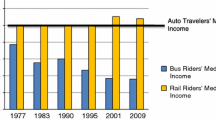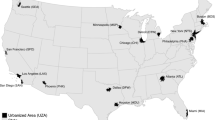Abstract
Virtually every U.S. bus system today charges its customers flat fares. Recent trends, however, suggest that passengers are traveling farther and proportionally more during peak hours, factors which have contributed toward transit's cost spiral. As deficits continue to soar and available funding tightens, current pricing rationales must be seriously questioned. This paper assesses the efficiency and equity impacts of three California transit agencies' fare structures. Short-distance, off-peak patrons are found to heavily cross-subsidize long-haul commuters. Fares differentiated by distance and time-of-day, in contrast, could improve the transit industry's fiscal posture while eliminating differences in payment rates. Barriers to their implementation remain formidable, however, both in terms of current fare collection capabilities and political acceptability.
Similar content being viewed by others
References
Altshuler, A. (1979). The Urban Transportation System: Politics and Policy Innovation. Cambridge: MIT Press.
American Public Transit Association (1981). Transit Fact Book, 1979–1980 edn. Washington, D.C.
Ballou, P. B., Hartgen, D. T. and Mohan, L. (1978). “Distance-based transit fares: Robin Hood or Sheriff of Nottingham?” PRR 145. Albany: New York State Department of Transportation.
Bly, P. H., Webster, F. W. and Pounds, Susan (1980). “Effects of subsidies on urban public transport,” Transportation 9: 311–331.
Cervero, R. B. (1980). “Efficiency and equity implications of transit fare policies.” Ph.D dissertation, University of California, Los Angeles.
Cervero, R. B., Wachs, M., Berlin, R. and Gephart, R. (1980). Efficiency and Equity Implications of Alternative Transit Fare Policies. Washington, D.C.: Urban Mass Transportation Administration.
Cherwony, W. and Mundle, S. (1978). “Peak-base cost allocation models,” Transportation Research Record 663: 52–56.
Dierks, P. A. (1975). “Financing urban transportation: A study of alternative methods to allocate operating deficits.” Ph.D dissertation, University of Washington.
Gutknecht, R. (1973). “Alternative Approachs to Public Transport Fares with Their Traffic and Revenue Implications.” Paper presented at the VITP 40th International Congress, Union International des Transport Publics, Brussels, Belgium.
Kemp, M. A. (1973). “Some evidence of transit demand elasticities,” Transportation 2: 27–38.
Leutze, C. B. and Ugolik, W. R. (1979). “Who pays the highest and lowest per mile transit fares,” Transportation Research Record 719: 32–34.
Levinson, H. S. (1978). “Peak-off peak revenue and cost allocation model,” Transportation Research Record 633: 29–33.
Lisco, T. E. (1970). “Mass transportation: Cinderella in our cities,” The Public Interest 28: 52–74.
Mayworm, P., Lago, A. M. and McEnroe, J. M. (1980). Patronage Impacts of Changes in Transit Fares and Services. Washington, D.C.: Urban Mass Transportation Administration.
Oram, R. L. (1979). “Peak-period supplements: the contemporary economics of urban bus transport in the U.K. and U.S.A.,” in D., Diamond and J. McLoughlin (eds.) Progress in Planning. Oxford: Pergamon Press.
Parker, G. B. and Blackledge, D. A. (1975). “RTM method of bus operations costing developed for the Bradford Bus Study,” Proceedings of the Symposium on Cost of Bus Operations. Crowthorne, England: Transport and Road Research Laboratory.
Pratt, R. M., Pederson, N. J. and Mather, J. J. (1977). Traveler Response to Transportation System Changes: A Handbook for Transportation Planners. Washington, D.C.: Urban Mass Transportation Administration.
Reilly, J. (1977). “Transit Costs During Peak and Off-Peak Hours.” Paper presented at the 56th Annual Meeting of the Transportation Research Board, Washington, D.C.
Rock, S. (1975). “The Redistributive Effects of Mass Transit in the Chicago Area.” Ph. D dissertation, Northwestern University.
Sale, J. E. and Green, B. (1979). “Operating costs and performance of American public transit systems,” Journal of the American Planning Association 45: 22–27.
Urban Mass Transportation Administration (1976). Increasing Transit Ridership: The Experience of Seven Cities. Washington, D.C.: National Technical Information Service.
Vickrey, W. (1973). “Current issues in transportation,” in N., Chamberlain (ed.). Contemporary Economic Issues. Homewood, IL: Irwin.
Author information
Authors and Affiliations
Rights and permissions
About this article
Cite this article
Cervero, R. Flat versus differentiated transit pricing: What's a fair fare?. Transportation 10, 211–232 (1981). https://doi.org/10.1007/BF00148459
Issue Date:
DOI: https://doi.org/10.1007/BF00148459




